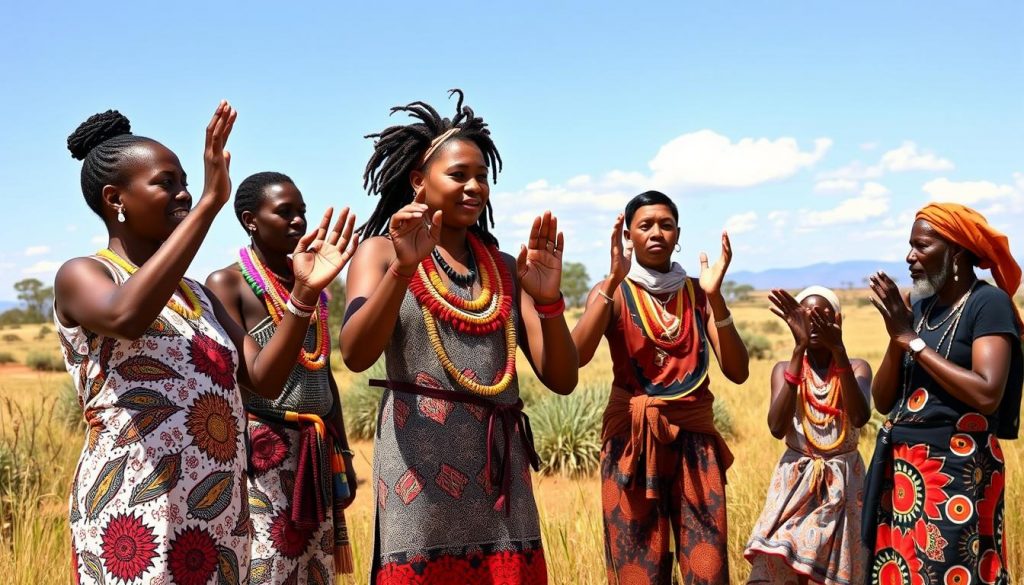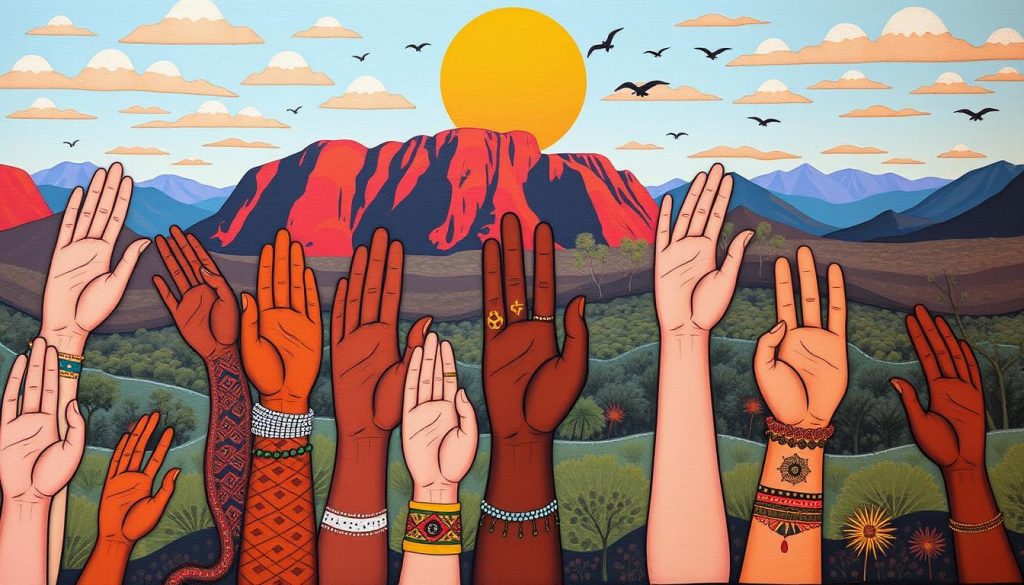Warlpiri Sign Language: A Silent Communication Among Australian Tribes.
Warlpiri Sign Language is a unique way of silent communication from Central Australia. It has about 1500 signs, making it a key part of Indigenous Australian communication. It’s especially important during mourning, when silence is both needed and valued.
Anúncios
This language is crucial in community life, showing the Warlpiri people’s rich culture. It’s not just for the hearing; many deaf Indigenous people use it as their main way to communicate. By learning about Warlpiri Sign Language, we see its role in the rich world of Aboriginal languages in Australia.
Introduction to Warlpiri Sign Language
Warlpiri Sign Language is a fascinating part of Indigenous Australian sign language. It’s mainly used by hearing people in Australian Aboriginal communities. It helps them communicate in special cultural ways.
Many Australian Aboriginal cultures have their own sign languages. These are like signed versions of their spoken languages. The Warlpiri and Warumungu groups in the central desert use these languages a lot. Their sign languages show the deep cultural values in their communication.
Studies show that Indigenous Australian sign languages are found in many Aboriginal communities. Warlpiri Sign Language is among the most developed. It’s used every day, in ceremonies, and during activities like hunting. It’s also used during mourning, as spoken language is sometimes restricted.
Anúncios
The Warlpiri people live in the Northern Territory of Australia, with about 3,000 members. Around 2,624 of them speak Warlpiri as their first language. This language is a big part of the Warlpiri language family, showing the rich diversity of languages.
In some areas, speech taboos lead to the use of Warlpiri Sign Language. This shows how important non-verbal communication is in these cultures. It highlights the unique role of sign language in Indigenous Australian cultures.
Understanding the Cultural Context of Sign Language
Sign language in Australian tribes is deeply rooted in culture. For over 65,000 years, traditional Indigenous communities have used it. It’s filled with social customs and respect for family ties.
In ceremonies, gender rules are strict. Certain signs are only for men or women. During mourning, signs help express grief without breaking the community’s peace. This shows how important family is in their daily lives.
When hunting, sign language is key to keep quiet. It’s about understanding the environment and social rules. This way, the tribe can hunt successfully while staying true to their culture.
Indigenous sign languages, like the Warlpiri’s, are vital to their identity. With over 300 spoken languages in Australia, sign languages help keep cultural stories alive. They make people feel connected to their heritage.
| Aspect | Sign Language Usage | Impact on Culture |
|---|---|---|
| Duration | Over 65,000 years | Foundation of cultural exchange |
| Diversity | Over 300 spoken languages | Multifaceted communication methods |
| Gender Roles | Ceremonial restrictions | Social harmony and respect |
| Kinship | Integral to silence practices | Strengthens community ties |
What is Warlpiri Sign Language?
Warlpiri Sign Language is a special way of talking created by the Warlpiri Aboriginal community in Australia’s North Central Desert. It’s known for its detailed features and has been studied a lot. Many linguists, like Adam Kendon, see it as a key part of Australian Indigenous languages.
This language has about 1,500 different signs. It’s a crucial tool for Warlpiri speakers. The signs match the spoken Warlpiri words, keeping the same order.

Warlpiri Sign Language is used in many social situations. During mourning, which can last years, some people, especially widows, use it a lot. In Yuendumu, older women are very good at it.
This shows the language’s deep tradition and how it fits with the community’s culture. Everyone in the Warlpiri community knows Warlpiri Sign Language. But women know it better.
It’s used in secret activities like hunting and private talks. This shows its importance in keeping respect and privacy in the community.
Warlpiri Sign Language is more than just a way to talk. It’s a key part of Warlpiri culture. It connects people and keeps important traditions alive in Australian Indigenous languages.
Social Functions of Warlpiri Sign Language
Warlpiri Sign Language is key to the Warlpiri community’s social life. It’s used for many important reasons, like in hunting where silence is needed. This helps the group work together better and succeed.
It also helps in tricky social situations. For example, when people need to talk to relatives but can’t because of cultural rules. These rules might be about mourning or showing respect. Warlpiri Sign Language lets people communicate without breaking these rules, keeping the community’s culture alive.
Warlpiri Sign Language is vital for daily life and building strong bonds. It helps everyone stay connected, making the community feel closer. This sign language makes communication easier and strengthens relationships within the Warlpiri community.
To sum up, Warlpiri Sign Language has many roles. Here’s a table showing some of its main uses:
| Social Function | Description |
|---|---|
| Silent Communication | Facilitates coordination during activities like hunting, where noise reduction is crucial. |
| Kinsfolk Communication | Allows communication under speech taboos, ensuring respect for cultural practices. |
| Community Bonding | Strengthens social relationships and deepens connections among Warlpiri members. |
| Cultural Preservation | Retains cultural heritage through non-verbal communication methods. |
The Role of Silence in Communication
In Warlpiri culture, silence is very important. It’s not seen as awkward or unengaged like in some Western cultures. Instead, it shows respect and understanding.
During mourning, people stay silent. This shows respect for the deceased and support for grieving families. It strengthens emotional bonds without needing words.
Studies show that non-verbal signals, like silence, add depth to communication. It helps build stronger relationships and community ties. Silence also carries deep cultural meanings, showing its value in Warlpiri society. For more on the cultural significance of silence, you can read more about it here.
Comparative Analysis with Other Indigenous Sign Languages
Warlpiri Sign Language has about 1,500 signs, as found by Adam Kendon. This large number comes from the Warlpiri people’s unique culture, especially during mourning. Widows use sign language, showing its deep emotional value.
Kukatja sign language was studied in Balgo, Western Australia. This area has many spoken languages. “Hand talk” is what locals call it, showing how language and identity are linked.
The Yolngu region is huge, covering nearly 40,000 square kilometers in North East Arnhem Land. Studies from 2009-2010 show Yolngu signing fits the environment and community life. It’s useful when speech is hard.
| Feature | Warlpiri Sign Language | Kukatja Sign Language | Yolngu Sign Language |
|---|---|---|---|
| Number of Signs | Approximately 1,500 | Not specified | Not specified |
| Cultural Usage | primarily during mourning> | General communication in diverse linguistic landscape | Holistic integration in various community functions |
| Geographical Span | Localized to Warlpiri community | Specific to Balgo region | Spans 40,000 square kilometers |
| Naming Convention | Not specifically documented | Hand talk | Silent form of coordination |
These sign languages show how culture and need shape language. Studies highlight their unique qualities and connections. Each language enriches community life and cultural stories in Australia.

The Linguistic Structure of Warlpiri Sign Language
The linguistic structure of Warlpiri Sign Language is quite interesting. It combines phonology and syntax in a unique way. This language, used by the Warlpiri people, has about 600 signs. Each sign has its own meaning, showing how organized this language is.
Sign language phonology focuses on how signs are made and their meaning. It shows how gestures and movements can convey messages. This is important for understanding visual and tactile communication.
Looking at Warlpiri syntax, we see how signs are put together. This allows for complex sentences and ideas. It’s especially important during mourning, when women mainly use signs.
Research in Yuendumu in 1978 was key. It involved filming over 10,000 feet of 16mm film. This showed how Warlpiri sign language is used in real life. It also showed that men and women use different signs, reflecting social differences.
| Aspect | Details |
|---|---|
| Signs in Lexicon | Approximately 600 signs |
| Fieldwork Length | 10,000 feet of 16mm film |
| Fieldwork Visits | 2 visits (June and October 1978) |
| Primary Users | Predominantly women during mourning |
| Men’s Knowledge | Significant but differs from women’s usage |
| Non-speaking Periods | Prolonged during bereavement |
| Community Bilingualism | High proportion with access to both modes |
| Preliminary Report Date | 1980 (SLS 27) |
This deep dive into Warlpiri Sign Language highlights its importance. It shows how phonology and syntax work together. This makes Warlpiri Sign Language a dynamic and culturally rich way to communicate.
Preservation and Future of Warlpiri Sign Language
The preservation of Warlpiri Sign Language is facing big challenges. These come from globalization and the spread of other languages. But, the community is working hard to keep Warlpiri alive through new projects. They focus on passing down their culture to younger generations, thanks to Indigenous language revitalization.
A new animal tracking training package is a big step forward. It was made by Warlpiri and North Tanami rangers. This program helps kids learn about Warlpiri animals, plants, and traditions.
For over 40 years, Warlpiri educators have worked together. They’ve made films, quizzes, and worksheets to teach kids. These tools help keep Warlpiri culture and language alive.
The Central Land Council supports these efforts. They provide places for training and learning. Teachers play a key role, adapting their teaching to respect Warlpiri culture.
The United Nations’ International Decade of Indigenous Languages (2022-2032) is a big opportunity. The release of the Warlpiri Encyclopedic Dictionary is a major milestone. It has over 1,400 pages and 500 illustrations, showing the community’s dedication to Warlpiri Sign Language.
Conclusion
The Warlpiri Sign Language is very important in Australia’s Indigenous communication. It has about 1500 unique signs from the Warlpiri language. This silent way of talking helps people talk every day and is linked to their culture, like hunting and mourning.
This language is key for community members to talk well in many situations. It’s especially important during hard times.
Knowing about Warlpiri Sign Language’s cultural value is key to keeping it alive. For example, when someone dies, Warlpiri women often don’t speak. They use sign language more, showing its sacred role in showing respect and mourning.
Sign language also shows different ways of expressing culture in many Indigenous groups in Australia. This shows how important it is to keep these languages alive.
It’s vital to support and protect Warlpiri Sign Language and other Indigenous ways of talking. More research and community efforts are needed to keep these languages as part of cultural identity and heritage.
By celebrating sign language, we add to Australia’s rich cultural mix. This helps ensure it stays alive for future generations.
